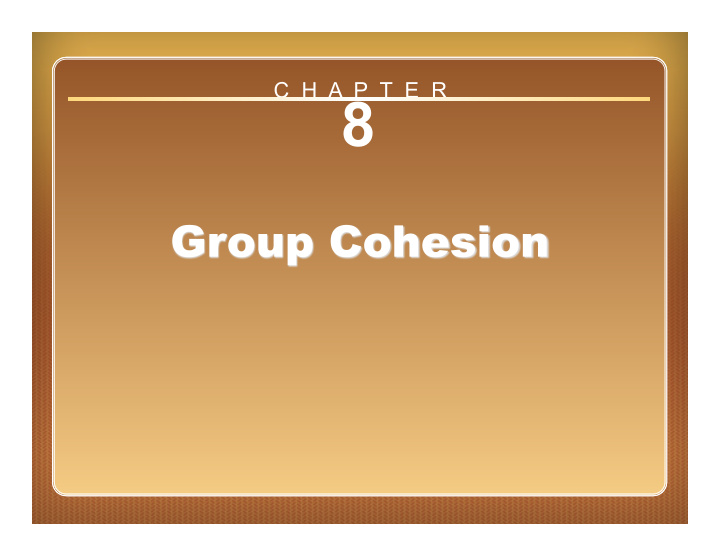



C H A P T E R 8 Chapter 8: Group Cohesion
Defining Cohesion • A dynamic process reflected in the tendency for a group to stick together and remain united in the pursuit of its instrumental objectives and/or for the satisfaction of member affective needs (Carron, Brawley, & Widmeyer, 1998) (continued)
Defining Cohesion (continued) • Task cohesion: The degree to which group members work together to achieve common goals and objectives • Social cohesion: The interpersonal attractions among group members
Figure 8.1
Measuring Cohesion • Questionnaires (e.g., Group Environment Questionnaire) focus on how attractive the group is to the individual members and how the members perceive the group. • Subscales: - Group interaction—task - Group integration—social - Individual attraction to group—task - Individual attraction to group—social
The Cohesion–Performance Relationship • Cohesion is positively related to performance. • Research has shown the cohesion– performance relationship depends on several factors: – Types of measures – Task demands (e.g., type of team) (continued)
The Cohesion–Performance Relationship (continued) • Types of measures – It was once thought that a positive cohesion– performance relationship existed with task cohesion measures, but there was no cohesion–performance relationship with social cohesion measures. – However, the most recent research shows that increases in both task and social cohesion are associated with increased performance. (continued)
The Cohesion–Performance Relationship (continued) • Task demands – Original research argued that the cohesion– performance relationship was stronger with interacting teams (e.g., volleyball) and that no relationship existed with coacting teams (e.g., bowling). – However, the most recent research has shown the task demands do not influence the cohesion– performance relationship. (continued)
The Cohesion–Performance Relationship (continued) • Circular relationship: Increased cohesion leads to greater performance and brings teams together, which, in turn, leads to still more cohesion.
Other Factors Associated with Cohesion • Team satisfaction: Increased cohesion is related to increased satisfaction. • Conformity: The more cohesive a group is, the greater its pressure to conform to the attitudes and behaviors of the group. (continued)
Other Factors Associated with Cohesion (continued) • Social support: There is a positive relationship between the social support an individual receives and that person’s evaluation of group cohesion. • Stability: Teams higher in cohesion can better resist disruption; teams staying together longer tend to be more cohesive.
Other Correlates of Cohesion • Group goals are tied to group cohesion. • Other factors are group status, role clarity and acceptance, group norms, decision style, collective efficacy, self-handicapping, gender.
Recommend
More recommend